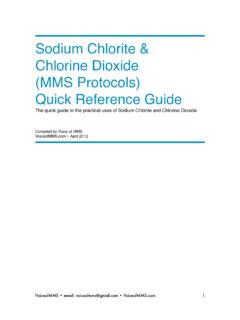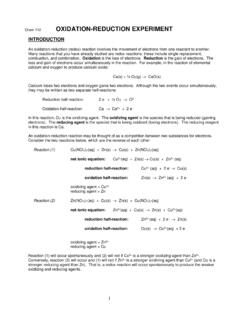Transcription of Safety Data Sheet 70% ALCOHOL LIQUID HAND SANITIZER …
1 Safety Data Sheet 70% ALCOHOL LIQUID HAND. SANITIZER FRAGRANCE. FREE. 1. Identification Product identifier 70% ALCOHOL LIQUID HAND SANITIZER FRAGRANCE FREE. Product code FLSANIH70FF118ML, FLSANIH70FF350ML, FLSANIH70FF500ML, , FLSANIH70FF20L, FLSANIH70FF208L, FLSANIH70FF1000L. Other means of None. identification Recommended use of Hand SANITIZER . the chemical and restrictions on use Manufacturer AEROCHEM Inc. 5977 Trans Canada Highway Pointe-Claire, QC. H9R 1C1. Canada General Information: 1-888-592-5837. Emergency phone INFOTRAC : 1-800-535-5053. number International call collect: 1-352-323-3500. 24 hours/day, 7 days/week 2. Hazard identification Flammable LIQUID . Keep away from heat, sparks and open flame. Avoid contact with eyes. Do not breathe vapors. Summary Do not ingest. If medical advice is needed, have this SDS or label at hand. WHMIS 2015/GHS/OSHA HCS 2012. Flammable liquids (Category 2).
2 Serious eye damage/eye irritation (Category 2B). DANGER. H225: Highly flammable LIQUID and vapour H320: Causes eye irritation P210: Keep away from heat, sparks, open flames and other ignition sources. No smoking. P240: Ground or bond container and receiving equipment. P241: Use explosion-proof electrical equipment. P242: Use only non-sparking tools. P243: Take precautionary measures against static discharge. P305+351+338: IF IN EYES: Rinse continuously with water for several minutes. Remove contact lenses if present and easy to do. Continue rinsing. P337+313: If eye irritation persists: Get medical advice or attention. P403+P235+P233: Store in a well-ventilated place. Keep container tightly closed. Keep cool. P501: Dispose of contents and container to a licensed chemical disposal agency in accordance with local, regional and national regulations. 3. Composition/information on ingredients Common name CAS Weight % content Ethyl ALCOHOL 64-17-5 70 %.
3 4. First-aid measures Inhalation Move person to fresh air. If a problem develops or persists, seek medical attention. Skin contact No first aid is necessary in normal use. In case of a spill, flush with water. Remove contaminated clothing and wash before reuse. If a problem develops or persists, seek medical attention. Eye contact Flush with water for at least 15 minutes. Remove contact lenses if easy to do. Hold eyelids apart to rinse properly. If a problem develops or persists, seek medical attention. Ingestion DO NOT induce vomiting, unless recommended by medical personnel. Never give anything by mouth if victim is unconscious or convulsing. If victim is conscious wash out mouth with water and give 1-2 glasses of water to drink. If a problem develops or persists, seek medical attention or contact a Poison Centre. Other No additional information. Symptoms May cause redness, tearing, and eye irritation.
4 Notes to the No additional information. physician 5. Fire-fighting measures Suitable extinguishing Dry chemicals, water fog, ALCOHOL resistant foam, carbon dioxide (CO2). Do not use a heavy water jet. media Specific hazards Highly flammable LIQUID and vapour. May be ignited by heat, sparks, flame or static electricity. arising from the Vapours are heavier than air and may travel to an ignition source distant from the material handling chemical point. Special protective Firefighters must wear self contained breathing apparatus with full face mask. Firefighting suit may not equipment be efficient against chemicals. Special protective Use water spray to cool fire-exposed containers. Water may be ineffective to extinguish a fire, actions for because mixtures of ALCOHOL and water are also flammable. Prevent run-off from fire control or dilution fire-fighters from entering streams, sewers or drinking water supply.
5 6. Accidental release measures Personal precautions, In the event of a large spill, wear nitrile or neoprene gloves. Wear chemical splash goggles. protective equipment and emergency procedures Environmental Prevent entry into sewers, closed areas and release to the environment. precautions Methods and Ventilate the area well. Remove sources of ignition. Absorb with inert material (soil, sand, vermiculite). materials for or wipe up with a damp mop and place in an appropriate waste disposal clearly identified. Finish containment and cleaning by rinsing with water contaminated surface. Never return the spilled product into its original cleaning up container for reuse. 7. Handling and storage Precautions for safe Keep away from heat, sparks and open flame. Use non-sparking and antistatic tools. Ground/bond all handling containers when transfering large quantities (5 gallons US or 20 L and more).
6 Use in well ventilated area. Avoid contact with eyes. Do not breathe vapors. Wear eye protection and other protective clothing that are adapted to the task being performed and the risks involved. Keep containers tightly closed when not in use. Do not eat, do not drink and do not smoke during use. Remove contaminated clothing and shoes and wash before reuse. Conditions for safe Storage and handling should follow the NFPA 30 Flammable and/or Combustible Liquids Code and storage, including any the National Fire Code of Canada (NFCC). Ground or bond large containers. Store tightly closed and incompatibilities in properly labelled containers in a cool, dry and well ventilated place. Containers that have been opened must be carefully resealed and kept upright to prevent leakage. Store away from oxidizing materials and incompatible materials (see section 10). Keep away from direct sunlight and heat.
7 Storage temperature <30 C (86 F). 8. Exposure controls/personal protection Immediately Ethyl ALCOHOL : 3300 ppm. Dangerous to Life or Health Ethyl ALCOHOL STEL 1000 ppm ACGIH , BC, ON. TWA (8h) 1000 ppm 1880 mg/m3 RSST. Appropriate Provide sufficient mechanical ventilation (general or local exhaust) to keep the airborne engineering controls concentrations of vapours, mists, aerosols or dust below their respective occupational exposure limits. Individual protection measures Eye In the workplace, wear Safety glasses with side shields. If there is a risk of contact with eyes, wear chemical splash goggles. Hands No protective equipment is needed under normal use conditions. In the workplace, wear Nitrile gloves. Disposable nitrile gloves can also be used, but discard after single use. Skin Wear work clothing as required by employer code. Respiratory No respiratory protective equipment is required under normal conditions of use.
8 Where the conditions in the workplace require a respirator, it is necessary to follow a respiratory protection program. Moreover, respiratory protection equipment (RPE) must be selected, fitted, maintained and inspected in accordance with regulations and standard 29 CFR (OSHA), ANSI or CSA Z (Canada) and approved by NIOSH/MSHA. In case of insufficient ventilation or in enclosed area until maximum 10 times of exposure limit, wear half mask respirator with organic vapors cartridges. Feet Wear rubber boots to clean up a spill. 9. Physical and chemical properties Physical state Viscous LIQUID Flammability Flammable. Colour Translucent Flammability limits to 19%. Odour Slight ALCOHOL odor Flash point 16 to 21 C ( to F). Tag Closed Cup tester Odour threshold N/Av. Auto-ignition 363 C ( F). temperature pH 7 Sensibility to Yes electrostatic charges Melting point <0 C (32 F) Sensibility to sparks No and/or friction Freezing point <0 C (32 F) Vapour density >1 (Air = 1).
9 Boiling point 78 to 79 C ( to F) Relative density to kg/L (Water = 1). Solubility Soluble in water. Partition coefficient N/Av. n-octanol/water Evaporation rate N/Av. Decomposition N/Av. temperature Vapour pressure <6kPa (45 mm Hg) @ 20 C (68 F) Viscosity N/Av. Percent Wt. Volatile >99% Molecular mass N/Ap. VOC (g/L) 602 to 609 g/L % Volume Volatile N/Av. (VOC). VOC (lb/gal) to lb/gal % Wt. Volatile (VOC) 70%. N/Av.: Not Available N/Ap.: Not Applicable Und.: Undetermined N/E: Not Established 10. Stability and reactivity Reactivity No reactivity expected. Chemical stability Stable under recommended storage conditions. Possibility of hazardous reactions A dangerous reaction will not occur. (including polymerizations). Conditions to avoid Avoid heat, flame and sparks. Avoid contact with incompatible materials. Incompatible materials Strong oxidizing agents ( chlorine, fluorine, nitric acid, perchloric acid, peroxides, nitrates, chlorates, chromates, permanganates and perchlorates).
10 Hazardous decomposition products No decomposition product. 11. Toxicological information Numerical Mixture Ingestion >2000 mg/kg Rat LD50. measures of Inhalation >20 mg/l/4h Rat LC50. toxicity Skin >2000 mg/kg Rabbit LD50. Ethyl ALCOHOL Ingestion 7060 mg/kg Rat LD50. Inhalation 39 mg/l/4h Mouse LC50. Skin 20000 mg/kg Rabbit LD50. Likely routes of Skin, eyes, inhalation, ingestion. exposure Delayed, Eye contact May cause itching, redness and skin irritation. Ethanol (CAS no 64-17-5) is moderately immediate and irritating to the eyes (Rabbit, OECD 405). chronic effects Skin contact Prolonged and repeated exposure may cause dry skin. Ethanol (CAS no 64-17-5) is not a skin irritant (Rabbit, OECD 404). Inhalation In the workplace, the product is rapidly absorbed by respiratory tract. May cause slight irritation of the respiratory system. Prolonged exposure may cause headache, dizziness and nausea.


